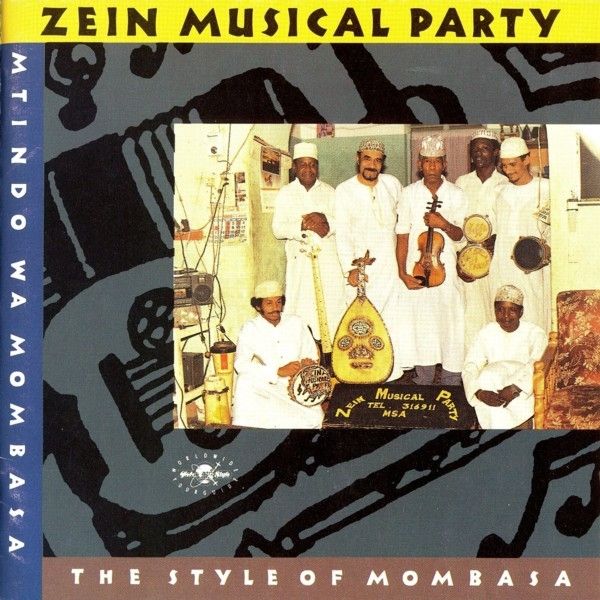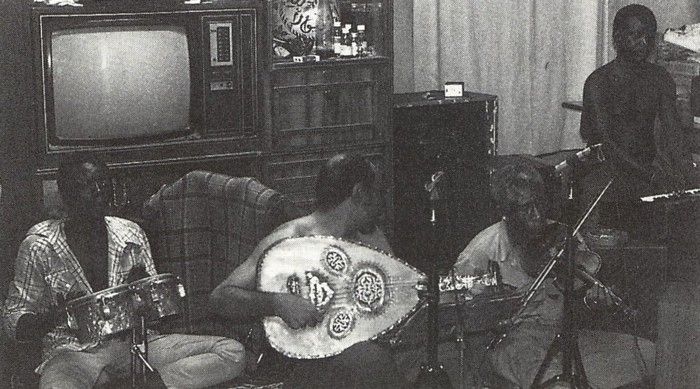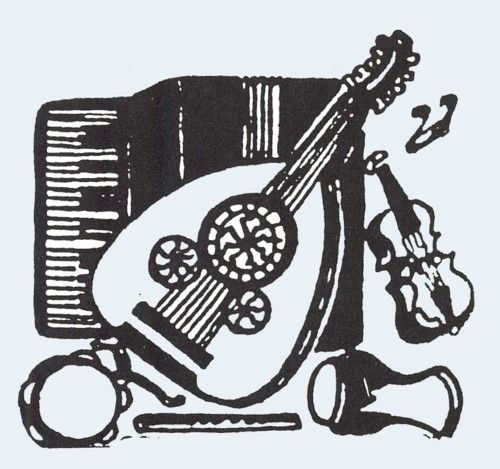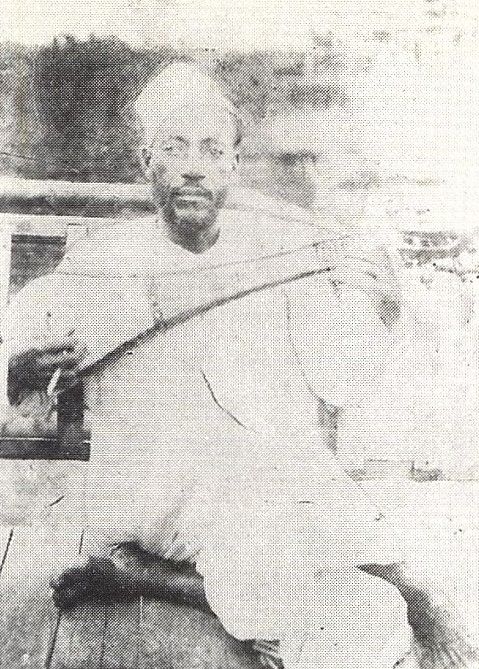
Ace · Globestyle CDORBD 066
1989

Ace · Globestyle CDORBD 066
1989
01 - Mtindo wa Mombasa [5:08]
“this is the way do things in Mombasa”
Zein L’Abdin Ahmed Almoody
Rhythm kumbwaya · Maqam bayati
02 - Maneno tisiya [6:25]
“nine reasons”
Mohamed Kijuma, Zein L’Abdin Ahmed Almoody
Rhythm twari · Maqam saba
03 - Wanawake wa Kiamu [12:01]
“the ladies of Lamu”
Mohamed Kijuma, Zein L’Abdin Ahmed Almoody
Rhythm kumbwaya · Maqam saba
04 - Taksim bayati [4:28]
Zein L’Abdin Ahmed Almoody
Maqam bayati
05 - Baina macho na moyo [6:27]
“between the eyes and the heart”
Khuleita Said Muhashamy, Zein L’Abdin Ahmed Almoody
Rhythm samba · Maqam shuri
06 - Mwiba wa kujitoma [5:04]
“a thorn in the flesh”
Zein L’Abdin Ahmed Almoody
Rhythm goma · Maqam hijazi
07 - Binti Mombasa [6:02]
“the daughter of Mombasa”
Ali Said Mashjury, Zein L’Abdin Ahmed Almoody
Rhythm wahed-u-nus · Maqam bayati
08 - Nataka rafiki [5:28]
“I want a friend”
Zein L’Abdin Ahmed Almoody
Rhythm chacha · Maqam hijazi
09 - Mwana hasahau mama [5:31]
“a child does not forget its mother”
Khuleita Said Muhashamy, Zein L’Abdin Ahmed Almoody
Rhythm kumbwaya · Maqam rast
10 - Taksim jirka [5:34]
Zein L’Abdin Ahmed Almoody
Maqam jirka
Zein L’Abdin Ahmed Almoody, ’ud & vocals
Mohamed Ahemd Bwanchuoni, violin
Bakari Salim, keyboard & dumbak
Juma Bakari Chera, bass guitar & bongos
Mohamed Hafidhi, dumbak, bongos & chorus
Omar Abdurasul, bongos & chorus
Mbarak Absillahi, rika (tambourine) & chorus
recorded in Mombasa, Kenya, februrary 1989

The lyrics of ‘Mtindo Wa Mombasa’ seem to be caught between
two lines of argument: one stresses the theme of community and
reciprocity, the other refers to the commercialisation of social
relations in today's Mombasa and the world in general. The two are also
a likely portrayal of the contemporary working conditions of taarab
musicians in Mombasa, being caught between the demands of community
still intact in many ways and the requirements of a commercial music
scene.
These features are also aptly mirrored in Zein's character and
lifestyle: Zein is a family man and his place in the Old Town of
Mombasa is always open to everyone from the community who wishes to pop
in. On the other hand Zein is strictly professional. While he tries to
keep away from the hustle and bustle of Mombasa's taarab scene and the
shrewd business acumen of some, he is a strict entrepreneur. For more
than ten years he has refused to record for others and has only
produced cassettes on his own, which he distributes from his living
room. Engagements are strictly cash, a fact criticised by the wazee,
Mombasa's honourables, who are sorry he does not like to just come out
and entertain them at their sit-togethers.
Zein might be an iconoclast — he never goes out except when he
has to play — but once he gets up in the early afternoon, his
place at ground level on Ndia Kuu Road, is open to a steady stream of
visitors, be they friends, relatives or the occasional customer wishing
to buy a cassette or arrange for him to play a taarab at their wedding.
Hot Arabic coffee or cold water for refreshment welcomes every visitor.
Zein's evenings are usually spent with friends and fellow musicians,
chewing miraa (a mildly narcotic twig), listening to and discussing
music — with him making a point here or there on the ’ud
— or watching videos. Once the scene gets quieter around midnight
he might get down to some more serious work, honing a new lyric until
it fits the formal demands of Swahili poetry and sounds good sung, or
working on a new song until the early hours of the morning.
It may seem a perfectly natural idea to record Zein and band in this
familiar environment, but it had its problems. After a first plan to
record in a local studio proved futile we decided to set up in Zein's
living room. We had to wait until close to midnight when the stream of
visitors lessened, and the street noise quietened. The door and windows
were shut and the recording space was additionally fenced off by
blankets spread across the room. We still had to cope with a few cars
and motorcycles passing at arm's length from the front door, and with
the video from upstairs. The ventilators and the fridge had to be
switched off during recording because of the hum they produced.
February is in the middle of the hot season in Mombasa and you may
imagine the amount of sweat produced during the two nights of
recording. If the sultry weather shows in these recordings at all,
good! Not all the conditions were adverse, and we should not forget to
mention the general hospitality of Zein and his wife, the delicious
foods, spiced tea and the ever-present cups of hot coffee. Shukrani
nyingi sana! If you can hear background sounds — street
noise, coughing, coffee cups rattling — this is perfectly
natural. What you hear is what we heard — the sound and style of
Mombasa.

ZEIN L’ABDIN AHMED ALAMOODY was born in Lamu on May 30,
1939. In his family, music and the other arts were highly esteemed. His
father played the ’ud as a pastime. Zein remembers a kibangala,
one of the old stringed Swahili lutes, hanging from the wall though he
never saw his father play it. Guests were often entertained with
musicians, and Baskuta was a regular visitor. Zein did not begin to
play the ’ud until after his father died in 1951 when he came to
Mombasa to live with an uncle. He attended school there up to 1954 but
had to stop because of some misunderstandings within the family. After
time back in Lamu he went to work as a hotel clerk in Mombasa. Around
this time he also picked up the ’ud. Zein was never formally
taught by anyone but learned by seeing, listening to and asking other
’ud players questions. He often went to the home of the tailor,
Omar Awadh Ban, a well known ’ud player of the time (who recorded
for the Jambo label in the late 40s), and stayed whole nights playing
and discussing music.
In 1957/58 Zein joined the ’ud player Ali wa Lela as a second
singer (wa Lela had worked at Zein's father's house in the 40s and had
picked up ’ud playing there). They recorded occasionally for
Sauti ya Mvita, the radio station at Mombasa. Wa Lela then went to the
Gulf states by invitation, but died there soon after. Zein finally
managed to get his own ’ud in around 1958, made by a local
craftsman. Three years later he got an instrument made in Arabia. At
that time he also left his work in the hotel and became a professional.
After a first recording for the Arrow label in the early 60s Zein
joined Mzuri Records, then Mombasa's main taarab outlet. He recorded a
host of singles up to the mid-70s, occasionally featuring other singers
with his band, at weddings and on records. Zuhura sang with his group
for a while and also Maulidi Juma. In the second half of the 70s Zein
recorded for Mbwana, a thriving cassette store in Mombasa's old town.
While earlier he had to rent his instruments and amplification from
that store he has since gone out on his own. Though the line-up is
smaller (he can no longer afford a bass player), the changes have done
him good. Zein plays regularly at weddings and distributes his own
cassettes (more than 50 titles in both Swahili and Arabic) from his
flat in Mombasa's Ndia Kuu Road. Once or twice a month he plays in one
of the tourist hotels on Mombasa's south coast. He does not consider
this a sell-out, and it is a regular sort of income. It also gives him
some independence from the wedding circuit, so he can pursue his own
musical direction.

THE MUSIC
Zein's group of the 70s featured the accordion, violin and bass in
addition to the obligatory percussion and his own ’ud. The
standard line-up for the past ten years has been: ’ud, violin,
keyboard, dumbak, bongos and rika (tambourine). On some tunes on this
CD, Juma Bakari, Zein's bass player through the 70s, was added to the
regular line-up.
While he went along with the demands of the Mombasa scene in the 60s
and early 70s, playing Indian-style taarab and including singers like
Zuhura and Maulidi, Zein has since abandoned going for the latest
trends, honing his own style rooted in the Lamu traditions: “For
some time I too have sung with an Indian tone like the others. But I
realised it is of no use. I have my own culture, I live my traditions,
it is awkward for a musician like me to follow foreign music. It does
not sound good.” Zein is no purist though. He keeps his
“reference collection” as he calls it, of music cassettes
from all over the world and likes Rai just as well as the Egyptian
star, Farid Al-Atrash or Salsa. That he knows the history of his
instrument and the links to Spanish traditions is shown when he
ventures from a classical taksim (an ’ud solo improvisation) via
some hot flamenco strumming into ‘Malagueña’.
Zein is one of the few contemporary taarab musicians who is well-versed
in the music's traditions. This includes his knowledge of Arabic music
theory — acquired from taping BBC Arabic music broadcasts which
featured ’ud virtuosos Jamil and Mounir Bashir and explained the
various maqamat (modes) — as well as the Swahili
traditions of ngoma rhythms and dances and the Swahili poetry
of old. Besides his repertoire of Swahili songs and his Swahili
cassettes, Zein also sings and records in Arabic. He is often invited
to play at the ‘Arabic weddings’ in Mombasa or to play for
visitors. His cassettes and ’ud playing are known and respected
as far as Yemen, the Gulf and Egypt.
There is no Swahili system of modes like the maqamat. The maqam
that comes closest to Swahili melodic traditions is saba. It is
no coincidence that this is the maqam used on the two oldest songs in
this collection ‘Maneno Tisiya’ and ‘Wanawake Wa
Kiamu’. Other maqamat featured here include bayati
(‘Mtindo Wa Mombasa’, ‘Taksim Bayati’, an
instrumental solo in maqam bayati, ‘Binti Mombasa’), shuri
(‘Baina Macho Na Moyo’), hijazi (‘Mwiba Wa
Kujitoma’, ‘Nataka Rafiki’), rast
(‘Mwana Hasahau Mama’) and jirka (‘Taksim
Jirka’).
The distinctive Swahili touch comes in terms of ‘voice’
qualities and especially in the rhythms and the dances and occasions
associated with them. In general these are derived from Swahili ngoma
— male and female dances, originally accompanied by the nzumari,
a type of oboe, ngoma (drums), or yugo (cow-horns beaten with a stick)
and various other percussion instruments.
The twari rhythm of ‘Maneno Tisiya’ derives from twari
la ndia, a street procession/dance originally performed at weddings
of better-class families. The goma is a dance that was performed by the
older, respected male members of society at religious festivities like
the Maulidi (birth of the Prophet Mohamed) or at weddings. The goma
rhythm backs up the song ‘Mwiba Wa Kujitoma’. Definitely
the most popular taarab rhythm along the coast is kumbwaya. The
kumbwaya is a kind of drum and also a dance that was danced for
amusement or to treat psychological disorders. The songs ‘Mtindo
Wa Mombasa’, ‘Wanawake Wa Kiamu’, ‘Mwana
Hasa-hau Mama’ use this rhythm. The wahed-u-nus of
‘Binti Mombasa’ is a rhythm from the Arabic peninsula and
simply means ‘one and a half’. The samba and chacha of
‘Baina Macho Na Moyo’ and ‘Nataka Rfiki’
respectively are self-explanatory.
The Zein Musical Party plays a style that the Swahili variously call
‘men's taarab’ or taarab ya Kiarabu. The taarab of the
likes of Maulidi, Zuhura or Matano in Mombasa or the various styles of
the Tanzanian coast from Tanga to Zanzibar are played at women's
wedding celebrations, hence ‘women's taarab’. (Check
“Mombasa Wedding Special” by the Maulidi Musical Party,
Globe. Style CD/ORBD 058 for a description of women's wedding
celebrations and taarab performed at these weddings). The latter kind
of taarab is also often referred to as taarab ya Kiswahili, or, because
of the Indian leanings of much of Mombasa's taarab, taarab ya Kihindi.
The Zein Musical Party plays at men's wedding celebrations, where the
main public are males, while the celebrations of the women are fenced
off with a curtain, according to Islamic customs. A special feature of
this kind of taarab are the dances performed by the wedding guests and
bridegroom. Some of the dances are from the Arabic peninsula and are
referred to by their geographical origin, like Sanaani (from Yemen) or
Kuwaiti. Seyyid Ah Baskuta, who witnessed the introduction of some of
these dances to the Lamu area in the early thirties, points out how the
dances introduced by sailors from Kuwait fitted incredibly well with
ngoma rhythms from Lamu and suggested an earlier link between these two
traditions. In fact African musical traditions have made many inroads
into the music of the Arabic peninsula and around the Gulf. Various
East African musical instruments and complete musical genres of African
origin are still performed today in Kuwait and southern Iraq.

LAMU AND SWAHILI
POETIC TRADITIONS
For centuries Lamu had been the acknowledged centre of Swahili culture,
famous for all aspects of the arts and especially for its poetry. The
expansion of the Omani court in Zanzibar throughout the second part of
the 19th century and the colonial onslaught from the turn of this
century onwards, and its concentration on the Mombasa-Nairobi axis, led
to the decline of Lamu as a port and trade centre. Zein in his youth
may have witnessed the last days of this past glory, when Lamu was a
major patron of the arts. There was an exodus of men to Mombasa and
other towns closer to the new centres of power after World War II. This
included Seyyid Ali Baskuta, the first ’ud player in Lamu, and a
walking thesaurus of Swahili musical traditions, and also the young
Zein. No professional taarab group operates in Lamu today.
Zein remembers his roots though: he speaks of his uncle Baskuta as
“the one who had the greatest impact on me in terms of his
knowledge and capabilities. He was always around while we grew up, he
played at our house when we had guests.” Another important
intermediary, a fellow Lamuan and one of Zein's neighbours in Mombasa,
is the well-known poet Sheikh Ahmed Nabhany. Nabhany owes his
reputation not only to the quality of his poetry, but also by
researching into and preserving the cultural traditions of Lamu and the
Northern Kenya coast. He introduced the ’ud player to the lyrics
of many of the old Lamu songs in his repertoire, ‘Maneno
Tisiya’ and ‘Wanawake Wa Kiamu’ among them. Zein also
sings a number of Nabhany's poems.
Both Baskuta and Nabhany name Mohamed Kijuma as one of the leading
poets and performers in Lamu around the turn of the century. Back then
the music was not called taarab, but the existing descriptions of the gungu
poetic contest/dance and the kinanda dance show a clear
similarity in character. Kijuma excelled not only as a singer and
player of the kinanda — or kibangala as it is called in Lamu (a
seven-stringed lute of the Swahili coast, related to the family of the gambus).
He was also a proficient dancer at the ngoma. After witnessing one of
his performances in Lamu, the Sultan of Zanzibar invited Kijuma to the
island to lead and train an orchestra and dancers. A photograph taken
in Zanzibar in 1907 shows Kijuma playing the kibangala. Popular memory
attributes the lyrics of both ‘Maneno Tisiya’ and
‘Wanawake Wa Kiamu’ to Kijuma's pen. ‘Maneno’
is an old wedding song which Kijuma may simply have preserved in
committing it to paper. ‘Wanawake’ honouring/describing the
beauty and character of the ladies of Lamu is close to another
masterpiece of Swahili poetry, the ‘Ode to the Lady of
Manga’ attributed to the mythic hero Liongo.
Zein's songbook contains more than 400 entries, the majority of which
are his own poetry. It is also common for well-known poets to give some
of their best poems to specific singers or musical parties to sing.
While these poems are committed to paper in the first place and have to
agree to well defined standards of rhyme, they are invariably meant to
be sung.
Werner Graebner
